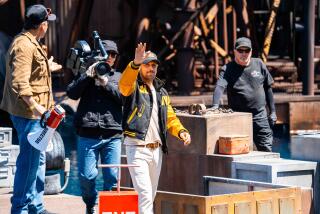Fox stunt: One funeral you can laugh about
- Share via
You may see a hearse rolling down Melrose Avenue this weekend or a candlelight vigil in a Coliseum parking lot before the USC football game.
But hold the tears -- most likely what you’ll be seeing is a stunt to promote the 100th episode of the Fox Broadcasting animated comedy “Family Guy.”
Marketers accompanying the hearse will hand out wanted posters for Stewie, one of the show’s characters, to play off a plot point in Sunday’s episode in which he reportedly carries out a plan to kill his mother, Lois. They’ll also pass out “Family Guy” candles in the hope that viewers will start candlelight vigils.
Similar stunts will be held in New York and Chicago. The hullabaloo for an animated character on TV underscores how networks are scrambling to attract viewers’ attention in an increasingly fragmented marketplace.
“We are competing with 300 to 500 channels, the Internet and video games, and life in general is very hectic,” said Joe Earley, executive vice president of marketing and communications at Fox Broadcasting Co. “We really have to do some nontraditional outreach to create word of mouth and buzz.”
Although no organization tracks how much networks are spending on these guerrilla stunts, Nielsen Monitor-Plus data indicate that networks may be rethinking the effectiveness of traditional advertising.
For instance, the three big networks plus Fox spent $3.8 million on local newspaper advertising in the first eight months of 2006, and only $1.8 million during the same period this year.
Hollywood publicity stunts are nothing new, of course. But in recent years their nature has shifted. Instead of generating water cooler talk, many promotions are aimed at making a direct connection with viewers. In September, for instance, Fox sent news vans from the fictional WURG-TV Channel 9 in Pittsburgh into the streets to promote the new television show “Back to You.”
Actors directed people to a website where they could create images of themselves as news anchors and then send those images to friends.
Engagement stunts work in a way that TV, radio or print ads don’t because they connect viewers with the show, said Scott Leonard, president of A.D.D. Marketing & Advertising, which coordinated both the “Back to You” and “Family Guy” stunts.
“It works because it brings the whole campaign to life,” he said.
“When you bump into the characters from a show that you love in real life you feel closer to it, you become more of a fan.”
These stunts can also target that elusive younger demographic. The hearse for the “Family Guy” stunt will drop by bars on the Sunset Strip, a concert venue, the USC football game, Westwood and the Venice boardwalk.
There are so many ads for television shows that it is often difficult to get people, especially the young and tech-savvy, to pay attention, said Stuart Fischoff, emeritus professor of media psychology at Cal State L.A.
But “with guerrilla theater, it’s different, it’s unanticipated, and it creates an experience,” he said.
And not always a good one. In January, Boston officials called in bomb squads to check out blinking objects on bridges and interstates, which turned out to be part of a guerrilla marketing stunt for a show on the Cartoon Network.
Earley would not share how much the “Family Guy” promotion is costing Fox but said that “it will pay for itself.” As advertising budgets tighten, he said, it becomes necessary to “spend smarter” to promote shows, buying traditional media and finding nontraditional ways to advertise as well.
Money to pay for the “Family Guy” initiative, for instance, is coming out of Fox’s publicity coffers, rather than the marketing budget.
The hope? That media coverage of the campaign will generate lots of buzz, without Fox actually having to spend much on a newspaper ad.
--
More to Read
The biggest entertainment stories
Get our big stories about Hollywood, film, television, music, arts, culture and more right in your inbox as soon as they publish.
You may occasionally receive promotional content from the Los Angeles Times.











